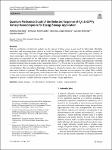Item Infomation
Full metadata record
| DC Field | Value | Language |
|---|---|---|
| dc.contributor.author | Anthony Chidi, Ezika | - |
| dc.contributor.author | Emmanuel Rotimi, Sadiku | - |
| dc.contributor.author | Gbolahan Joseph, Adekoya | - |
| dc.date.accessioned | 2023-04-21T02:32:24Z | - |
| dc.date.available | 2023-04-21T02:32:24Z | - |
| dc.date.issued | 2023 | - |
| dc.identifier.uri | https://link.springer.com/article/10.1007/s10904-023-02578-z | - |
| dc.identifier.uri | https://dlib.phenikaa-uni.edu.vn/handle/PNK/8186 | - |
| dc.description | CC BY | vi |
| dc.description.abstract | With the proliferation of electronic gadgets and the internet of things comes a great need for lightweight, affordable, sustainable, and long-lasting power devices to combat the depletion of fossil fuel energy and the pollution produced by chemical energy storage. The use of high-energy-density polymer/ceramic composites is generating more curiosity for future technologies, and they require a high dielectric constant and breakdown strength. Electric percolation and Interface polarization are responsible for the high dielectric constant. To create composite dielectrics, high-conductivity ceramic particles are combined with polymers to improve the dielectric constant. In this work, ternary nanocomposites with better dielectric characteristics are created using a nanohybrid filler of V2C Mxene-ZnO in a polypyrrole (PPy) matrix. | vi |
| dc.language.iso | en | vi |
| dc.publisher | Springer | vi |
| dc.subject | V2C Mxene-ZnO | vi |
| dc.subject | polypyrrole (PPy) matrix | vi |
| dc.title | Quantum Mechanical Study of the Dielectric Response of V2C-ZnO/PPy Ternary Nanocomposite for Energy Storage Application | vi |
| dc.type | Book | vi |
| Appears in Collections | ||
| OER - Khoa học Tự nhiên | ||
Files in This Item:

